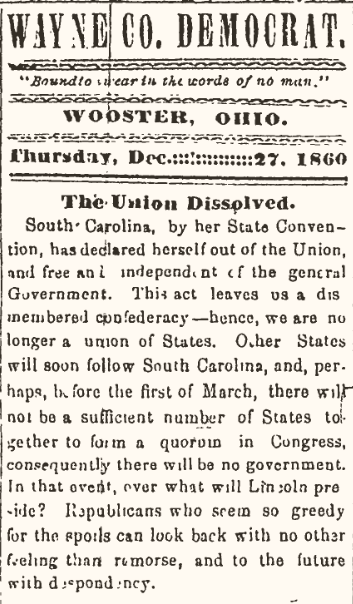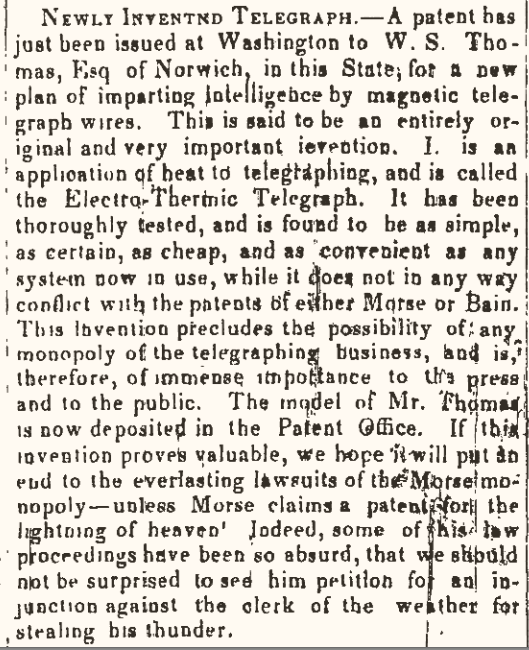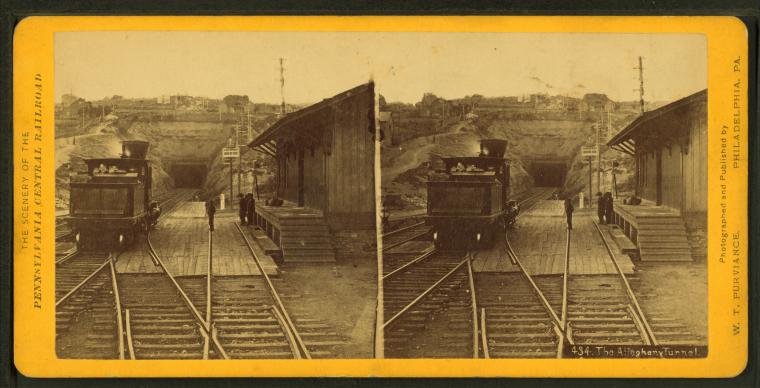National and Local Context
- Home
- Community in the Columns
- Special Exhibitions
- National and Local Context
The nineteenth century was a time of great national uncertainty and change. Railroads and telegraphs began to spring up throughout the nation, and the question of slavery would redefine the American political, economic, and moral landscape.

Politically, the nineteenth century was one of great turmoil. The election of Jackson in 1828 marked the rise of the “common man” in American politics, and as states extended the vote to the common man, Jackson swept into office and ignited political interest among common people around the country. The Wayne County Democrat was founded by enthusiastic Jackson supporters, and ran a Jackson quote as the tagline of the paper for decades.1 With the election of Jackson, small town newspapers stepped into their own as forums for political discussion. The 1845 Annexation of Texas led to the Mexican American War, which (among other things) greatly expanded United States territory. This expansion put new urgency on the question of slavery. All this new land would have to be admitted to the Union at some point: would it be slave, or free? The “slavery question” became a political lightning rod that electrified American politics. The dissolution of the Union, the abolition of slavery, and the North South divide is the most lasting political legacy of the nineteenth century. The question of slavery was seemingly settled in 1865, with the passage of the Thirteenth Amendment. But the question of equal citizenship under the law would continue to plague the nation well beyond the nineteenth century.
It is worth noting that for the latter half of the nineteenth century, Wayne County had a small but persistent Democratic majority. The state of Ohio tended to lean Republican, but the state was very “purple” — perhaps even more so than today. This local political dynamic informed the newspapers to an incredible degree. The Wayne County Democrat and Wooster Republican were constantly vying for readers and influence in the politically diverse landscape of Wayne County.
Technologically, the nineteenth century was a time of great advancement. The most dramatic of these man-made miracles were the railroad and the telegraph. The first passenger train pulled into Wooster in 1852, bringing news and goods from the outside world. Railroad timetables were printed in the weekly paper for Wooster citizens hoping to catch a train or waiting for a package. “I hear the whistle of the locomotive in the woods,” wrote Ralph Waldo Emerson. “It is the voice of the civility of the Nineteenth Century saying, ‘Here I am.’”2 The second invention was no less influential. The Wayne Count Democrat announced in March 1850 a “Newly Invented Telegraph,” describing the telegraph as “an entirely new and very important invention.”3 By 1880 the newspaper was less enthralled with the telegraph, observing darkly that “‘lies go by telegraph; the truth comes by mail three hours late.”4 Although Wooster was largely agricultural, it was still affected by the Industrial Revolution and the expansion of the national community. Railroads and telegraphs both served to change Wooster from an island community to an integral part of the national community. By the end of the nineteenth centuries, Wayne County newspapers were covering the same stories as New York City tabloids, and ads for out-of-state delicacies were splashed across nearly every page.
The nineteenth century was a time of increased religious awareness, education, political engagement, technology, national conflict, and community expansion. These forces played out on the national stage, but also impacted life in Wayne County. From fiery columns about slavery to cheerful ads for oysters to railroad timetables, it is impossible to separate the local and national context from Wayne County newspapers.
Footnotes:
1: “Wayne County Democrat,” Wayne County Public Library. https://ohiomemory.org/digital/collection/p16007coll53
2: Jill Lepore, These Truths (New York: W.W. Norton and Company, 2018), 229.
3: Wayne County Democrat, March 21, 1850, 1.
4: Wayne County Democrat, May 5, 1880, 1.



